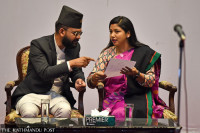Kathmandu
As monsoon nears, KMC starts repairing road to Bancharedanda landfill site
Officials are mulling buying a high-pressure pump to prevent landfill leachate from contaminating the local river.
Arjun Poudel
With the monsoon just around the corner, the Kathmandu Metropolitan City has finally started repairing the Sisdole road that leads to the Bancharedanda landfill in Nuwakot district. Officials said they started fixing potholes, concreting and other works on Wednesday.
“We have allocated Rs30 million for the repairs, and the work started on Wednesday after completing the tender process,” said Rabinman Shrestha, chief of the Environment Department of the Kathmandu Metropolitan City (KMC). “We have asked the contractor to complete the work at the earliest in view of the looming monsoon.”
Every year, garbage disposal is affected during the monsoon season due to rain, landslides, and poor road conditions. Sometimes, garbage disposal is disrupted due to obstructions by the residents living in settlements near and around the landfill site. These obstructions result in a complete halt in door-to-door garbage collection for weeks, leading locals in the Valley to discard their trash on the streets and causing chaos in the city.
“We are aware of the risks associated with obstructions in garbage disposal and their consequences,” said Shrestha. “We have been taking measures accordingly to lessen all possible risks.”
The metropolis said that around 200 metres of road near the Sisdole area, which is often damaged by garbage trucks and excavators, will be concretised.
Meteorologists in Nepal anticipate the onset of monsoon by the end of next week, a few days ahead of the usual June 13 arrival of the weather system from the Bay of Bengal.
KMC is also considering purchasing a high-pressure pump to prevent the overflow of leachate from the dumping ground. Recently, locals in the Sisdole area protested and stopped the trucks from disposing of garbage alleging the KMC’s negligence in leachate control.
Municipal officials said that the Ministry of Urban Development took away a high-pressure pumpset from the landfill site's leachate pond some three months ago for maintenance, but has yet to return it.
Landfill leachate is a hazardous liquid containing harmful bacteria, chemicals and other components. It forms when rainwater passes through a landfill or when organic matter decomposes naturally.
Officials say the leachate needs to be re-injected into the landfill, which quickens the decomposition process of the landfill waste and prevents the liquid from flowing into the river.
The city office has also started segregating degradable and bio-non-degradable waste materials from households in its seven wards. Wards 5, 7, 10, 12, 24 and 27 have been segregating the waste materials generated in the households. The city office has also arranged separate trucks for collecting segregated waste materials from the households.
Degradable waste materials are being turned into compost at the KMC’s waste transfer station. Officials said that the metropolis has also been using reagents to expedite the compost-making process.
Waste segregation at the source was one of the measures Mayor Balendra Shah touted as a solution to Kathmandu’s chronic garbage problem. After he assumed office, Shah asked city residents to start segregating waste at the source. They started doing so, using separate bins in their homes. But the plan didn’t work, largely due to a lack of preparations on the KMC’s part.
The Kathmandu Valley generates over 1,200 tonnes of solid waste every day, nearly 60 percent of which comes from the KMC alone. Experts say 60 percent of organic waste originating in the Valley can be converted into compost and the remaining 30 percent of non-degradable waste can be recycled.




 20.2°C Kathmandu
20.2°C Kathmandu











